|
Appendix I: The Leland-Boker “Authorized Edition” of the Emancipation Proclamation |
|
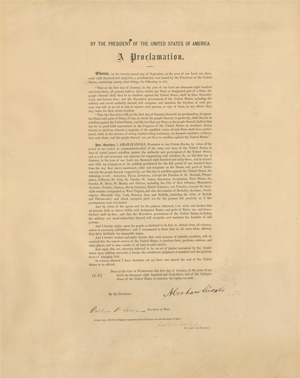
|
|
David Rubenstein's Copy - Courtesy of Seth Kaller |
Nine Lincoln-signed copies of the Emancipation Proclamation have sold publicly in the last 40 years. I have had the privilege of acquiring and placing eight with institutional and private clients. Here, I am delighted to share the historic background we have gathered in the process.
Please ask if you wish to re-publish or broadcast any of this information; it is almost always granted. Free use is allowed for schooling at any level, but the information should be credited to Seth Kaller, Inc., with a link to our website. Depending on the use, better quality images may also be provided. Requests by museums to borrow client’s documents, or to provide for display exact size fine quality reproductions, is often considered, and accommodated whenever possible.
I am always interested in updating the census (list of known copies); if you know something we don’t, please tell! Also, if you own a related document, or work for a museum or library owner, and can grant us permission to publish an image, please let me know.
Sincerely,
Seth Kaller
ABRAHAM LINCOLN. Document Signed as President, “Authorized Edition” of the Emancipation Proclamation, co-signed by William Seward as Secretary of State, and John Nicolay as Private Secretary to the President. Washington, D.C., January 1, 1863 [but printed and signed 1864]. 1 p., 17¼ x 21¾ in., J. Whatman watermarked paper.
President Abraham Lincoln issued the Emancipation Proclamation on January 1, 1863. This “Authorized Edition” was created in 1864 to aid Union troops. It was signed by Abraham Lincoln, Secretary of State William Seward, and John Nicolay, the President’s private secretary, to be sold at the Philadelphia Great Central Sanitary Fair. In Lincoln’s words, the fairs raised money “to relieve and comfort our brave soldiers.”
Of only 48 copies signed by Lincoln, 26 are known to survive; most are in (or expected to be donated to) institutions.
|
Press Coverage of our Emancipation Proclamation Auction
|
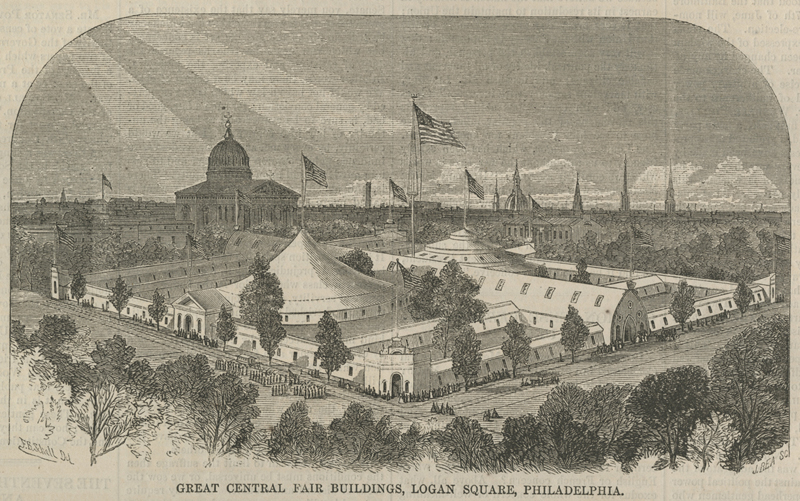
This “Authorized Edition” was printed and signed in June of 1864, to be sold at the Philadelphia Great Central Sanitary Fair. The fairs were created by the United States Sanitary Commission, which worked to raise money for sick and wounded soldiers, provide nursing, uniforms, and supplies, and to improve conditions in military camps. The Philadelphia fair, held in Logan Square from June 7 to 29, was the only event of its kind attended by Lincoln. On June 16, the president’s passionate speech caused such an outpouring of emotions among spectators that officials decided it would be dangerous for him to attend another. The president avowed:
|
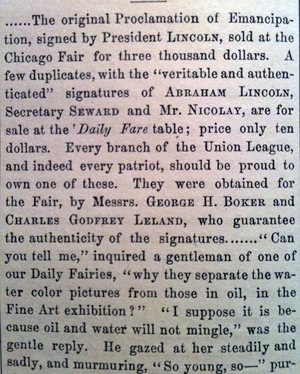
|
|
Advertising the Leland-Boker Authorized Edition for sale at the fair (Library Company of Philadelphia) |
War at its best, is terrible, and this war of ours, in its magnitude and in its duration is one of the most terrible....it has carried mourning to almost every home, until it can almost be said that the ‘heavens are hung in black.’ Yet the war continues....The Sanitary Commission, with all its benevolent labors...[has] contributed to the comfort and relief of the soldiers....The Commission provides voluntary contributions, given zealously, and earnestly, on top of all the disturbances of business, of all the disorders, of all the taxation, and of all the burdens that the war has imposed upon us, giving proof that the national resources are not at all exhausted, and that the national spirit of patriotism is even firmer and stronger than at the commencement of the war.
|
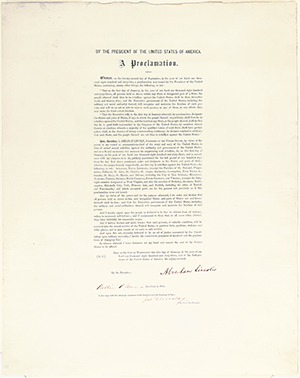
|
|
Private Collection Copy - Courtesy of Seth Kaller |
When Northerners attended fairs, donated money or goods, or volunteered their time, they were actively aiding the soldiers on the front lines. Autographs of leading Americans were often sold at the fairs. Lincoln donated a signed autograph manuscript of the Gettysburg Address to the New York Fair, which reportedly sold it for $1,000. For Chicago’s Great Northwestern Fair, Lincoln donated his original signed draft of the Emancipation Proclamation, with an accompanying letter stating his “desire to retain the paper, but if it shall contribute to the relief or comfort of the soldiers, that will be better.” It sold for an astounding $3,000. Unfortunately, that manuscript document was destroyed in the Chicago Fire of 1871.
As in all of Lincoln’s presidential documents, he signed this example with his full name instead of the less formal “A Lincoln” that he used on almost all letters and notes. His bold signature stands out from Seward’s and Nicolay’s partly due to his heavier hand and partly because of his use of a steel-tipped pen.
The present dramatic printing is executed on Whatman paper, known since the 1760s for its high quality. Used by George Washington and Thomas Jefferson for state papers, Queen Victoria for personal correspondence, Napoleon Bonaparte for his will, and John James Audubon for his spectacular bird prints, it is no surprise that the two prominent Philadelphia men who created this Emancipation Proclamation chose it as the medium for their authorized printing.
 Charles Godfrey Leland (1824 - 1903) studied with transcendentalist Amos Bronson Alcott before attending Princeton. In 1857, he became editor of Graham’s magazine, and in 1862, he took charge of the Continental Monthly, a Boston newspaper dedicated to the Union cause. In that role, Leland claimed to have “coined the term emancipation as a substitute for the disreputable term abolition.” In 1863, he enlisted in a Pennsylvania artillery regiment that fought at Gettysburg. Charles Godfrey Leland (1824 - 1903) studied with transcendentalist Amos Bronson Alcott before attending Princeton. In 1857, he became editor of Graham’s magazine, and in 1862, he took charge of the Continental Monthly, a Boston newspaper dedicated to the Union cause. In that role, Leland claimed to have “coined the term emancipation as a substitute for the disreputable term abolition.” In 1863, he enlisted in a Pennsylvania artillery regiment that fought at Gettysburg.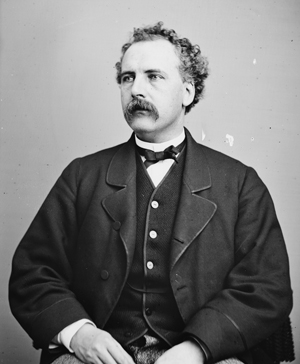
George Henry Boker (1823 - 1890), the scion of a banking family, also attended Princeton. A founder of the Union League Club of Philadelphia, he was active in raising funds for the Union wounded and aiding families of soldiers and sailors. During the war, Boker published “Tardy George,” a poem critical of General George McClellan, and another titled “The Black Regiment.”
Emancipation Proclamation Census: The Leland-Boker “Authorized Edition”
Institutional Collections
1. Abraham Lincoln Presidential Library, Springfield, IL
2. Boston Athenaeum, Boston, MA
3. British Library, London, UK
4. Brooklyn Historical Society, Brooklyn, NY
5. Gilcrease Museum, Tulsa, OK
6. Gilder Lehrman Collection on deposit at The New-York Historical Society, NY
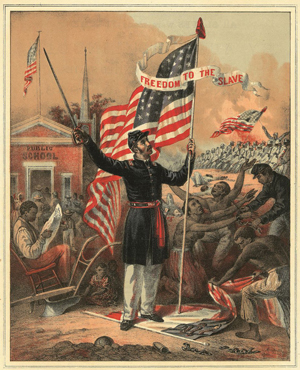 |
|
The opportunities of the Emancipation: The possibility of freedom, education, military service, and citizenship (The Gilder-Lehrman Collection, on Deposit at the New-York Historical Society) |
7. Historical Society of Pennsylvania, Philadelphia, PA
8. Huntington Library, Pasadena, CA
9. Indiana University, Lilly Library, Bloomington, IN
10. Library of Congress, Washington, DC
11. Lincoln Financial Foundation Collection, Indiana State Museum, Indianapolis, IN
12. Meisei University, Tokyo, Japan
13. National Constitution Center, Philadelphia, PA (on deposit)
14. New-York Historical Society, New York, NY
15. Princeton University, Princeton, NJ
16. Union League Club of Philadelphia, Philadelphia, PA
17. University of Chicago, Chicago, IL
18. University of Delaware, Wilmington, DE
19. University of Pennsylvania, Philadelphia, PA
Private Collections
20. Private, ex-Robert F. Kennedy, Sotheby’s December 10,2010
21. Private, CT, museum deaccession, 2010
22. David Rubenstein, ex-Malcolm Forbes. On loan to Smithsonian Museum of African American History & Culture.
23. Private, NY, ex-Sotheby’s October 31, 1989 and May 25, 2016.
24. Private, CT, ex-Christie’s May 22, 2001
25. Private, Los Angeles, CA
26. Private, Northern CA
27. David Rubenstein, ex-Siegel Auction Galleries June 26, 2012. On loan to Lincoln Cottage.
The copies listed in bold were bought, brokered, or sold through Kaller. One or more copies sold privately in the late 1980s and early 1990s, with no way for us to trace current ownership or to know if those are already included on this list. For the privately-owned copies, auction dates have been included to allow for continued tracking. Most of the copies known in private hands are not expected to return to the market.
Next Page: Appendix II: Manuscripts and Other Signed Editions of the Emancipation Proclamation
|